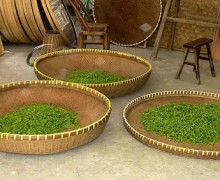 Recently, I was asked about a press release from April of this year from Greenpeace China about pesticides found in tea being sold in Beijing markets for Chinese consumers. I thought that I had written a blog on this, but instead I had participated in a Linkedin discussion primarily with other tea professionals. First, I want to underline that the teas that were tested were not meant for export, and there are two completely different standards where pesticides are concerned. Greenpeace did not present a very scientific case, and also failed to present the appropriate context for the information that they were trumpeting. I’ll try to do that here. Here are links to the Greenpeace site, so that you can evaluate for yourself. The report.
Recently, I was asked about a press release from April of this year from Greenpeace China about pesticides found in tea being sold in Beijing markets for Chinese consumers. I thought that I had written a blog on this, but instead I had participated in a Linkedin discussion primarily with other tea professionals. First, I want to underline that the teas that were tested were not meant for export, and there are two completely different standards where pesticides are concerned. Greenpeace did not present a very scientific case, and also failed to present the appropriate context for the information that they were trumpeting. I’ll try to do that here. Here are links to the Greenpeace site, so that you can evaluate for yourself. The report.
Here is what Nigel Melican, one of the leading tea experts in the international tea industry, had to say on Linkedin in case you missed it.
“(i) Pesticides traces are universal in food – no tea in the world can have absolutely totally zero pesticides – nor can or does an organic apple or carrot. Consequently Maximum Residue Levels (MRLs) are set by importing countries. Presence of a chemical below the maximum safe level is accepted – but Greenpeace (through ignorance or ingenuousness) ignores this and rants against “drinking toxic pesticides in their tea” while naming and shaming some tea companies with well below MRL levels – no libel laws in China?
(ii) No reference is made in the lengthy Greenpeace China report to MRLs – particularly the EU MRLs which are internationally accepted. In fact, if you take the considerable trouble of comparing the Greenpeace data with EU pesticide limits for the 28 chemicals mentioned then 5 of the 18 teas accused actually fall below the MRL limits for all 28 and two more tea exceed by a trace level of 1 mg/kg on 2 chemicals. This leaves 11 teas non-compliant for one or more pesticides, were they to be sold in the EU.
(iii) These teas were purchased in the local Chinese market so Greenpeace China should have been comparing them with Chinese MRL legislation – they may very well be compliant with this (I do not have access to Chinese MRLs).
(iv) Nowhere in the report does Greenpeace China suggest that the non compliant teas are representative of China teas presented for Export – but commentators in the USA and UK have erroneously and immediately jumped to this conclusion.”
I would like to add that there are very strict penalties for trying to export contaminated Chinese teas, and as Nigel rightly points out, the MRLs are set by the importing country. China is very conscientious about inspecting tea for export, and does real testing. Testing for contaminates is relatively inexpensive. The Chinese government is very serious about not having another food contamination scandal, notice there hasn’t been one since 2008, when they beefed up their export laws. (Don’t forget that they shot the head of the Chinese FDA over contaminated drugs.)
It is also interesting that the two biggest culprits in the Greenpeace expose were not even Chinese companies, they included Lipton and Ten Fu/Ten Ren. Lipton is the leading brand in China, largely because there really aren’t any national Chinese brands, and Ten Fu which Americans know as Ten Ren is a Taiwanese company, and is probably the leading tea retailer in China. They are in almost every large super market that you go to.
I think what burns me most is that people jump to the conclusion that China is a monolithic country, and that a couple of tainted companies represent all of China, given that there are 70 to 100,000 producers in China. In 2009 China produced 22,000 tons of organic certified tea. That is a lot of tea.
Austin
